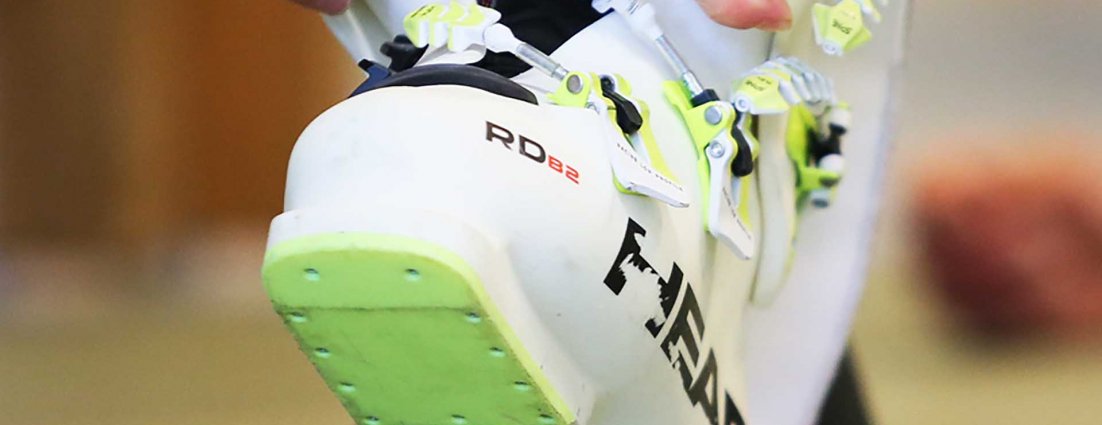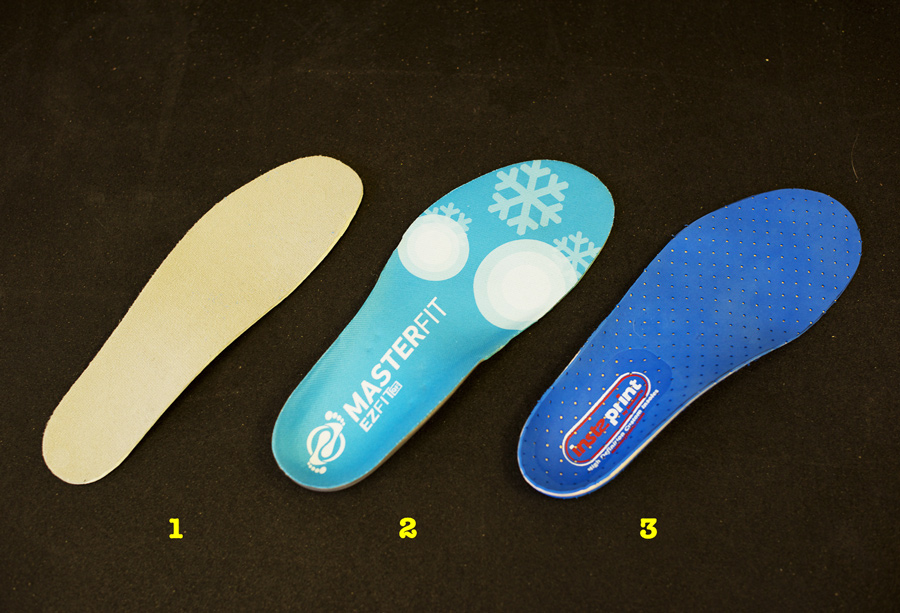Do Top Racers Use Footbeds?
02.04.2017 | Nastar Editor

Do your feet ache after you’ve been training gates with NASTAR all day? Sometimes, racing with a footbed can help you out, other times, not as much.
Before I answer if top ski racers use footbeds, let’s clarify a few terms, concepts and applications. A footbed - the insert slipped in between your foot and the liner - should be perceived no differently in ski boots than building a foundation for a solid house. If the foundation is off, the walls will not be straight, and the roof will show the result.
What does a footbed even do? In the simplest terms, a custom footbed should do nothing more than contain the heel of the foot, control or neutralize the ankle joint in a parallel relationship to the ground, and distribute pressure evenly throughout the entire underside of the foot by taking up any empty space.
Have I lost you yet?
Try this exercise: Take your shoes and socks off and sit on a chair with your feet resting on the ground. Keep your knees and legs parallel and hip width apart. Also, make sure your ankle and knee joints mimic a 90 degree side profile. Have someone take a picture of your feet from the front, interior, outside and back. The majority of the images should show “normal” foot shapes with the toes relaxed, a relatively slender midsection of the foot, what looks to be both ankle bones slightly exposed, and the Achilles’ tendon that attaches to the top of the heel in a fairly straight line or perpendicular to the ground. There should possibly be enough space for one or two fingers to fit between the floor and the arch of the foot. Now stand up and take the very same pictures. What are the differences? My guess, based on upwards of 400 stance assessments per year, is that your feet will elongate some, toes will tense up, feet will get a bit wider, arches will flatten and roll in or possibly out, specific pressure spots will increase under your feet, the ankle bones will become more pronounced in one direction, a new navicular bone might pop out on the inside of your ankle, and the angle of your Achilles’ from behind may develop a curve.
Some feet change only slightly between sitting and standing, while others might resemble different feet altogether. The difference between a seated, semi-weighted natural foot shape and the standing, unsupported foot is what we want to account for with a custom footbed. People may argue that we stand while skiing, but if the natural foot shape changes once loaded due to weaker muscle and bone structure, then we are setting ourselves up for many painful fit and alignment issues in addition to a tremendous loss of balance and inefficiency on snow.
While flexing ankles slowly and repeatedly, compounding turn after turn, you can foresee the loss of balance, response and power that would be applied inside the boot, as well as painful bone spurs developing from friction inside the boot, sore arches, cold and numb toes jamming the front of boot, and definitely some alignment issues of the lower leg shafts.
Final step to the exercise, both seated and standing. Place either the stock footbed that came with your boot or an aftermarket footbed under your feet and repeat the above steps. If the feet and ankles remain stable and the underside shape is matched, you’re starting off in a great spot! If things change too much or gaps in contact are noticed, a new footbed may be in your future.

Back to that earlier house analogy: If the base starts getting skewed in one direction, each layer above has to offset in the opposite direction to support the top. This will be the same for the whole joint chain within your leg. If the ankle goes one way, the knee goes the other and hips follow in yet another direction. Before you know it, your joints cannot handle the natural flexion and extension motions needed to maintain balance, add and release pressure, and absorb terrain. So, if a custom footbed is built effectively, the change in foot shape will be minimal to none, the feet will have a comfortable and relaxed foundation of support, and the consequent body structure above will be more likely to maintain dynamic balance.
Proprioception is the term I use to explain the need for feel inside the boot. If you are suspended in your boot, or most of the body weight falls on a few points of contact, it is much harder to use the whole foot to adjust or play around with ski engagement and direction, and develop that top-level feel and touch you hear elite racers describe. A certain amount of movement is actually necessary and warranted, but having a home base neutral position to return to is key! Knowing how much energy to exert from which tiny part of the foot to transmit that energy is a high-level skill developed over many years and thousands of turns.
As well, having a consistent yet pliable footbed underfoot will help transmit feedback from the ski and snow surface to the feet in order to help hone that skill. What we don’t want is an “all on/all off” blocked foot either.
Because I’m often asked, “Why don’t top racers use footbeds?”, I have to argue that 98 percent of the athletes I work with do actually use them, in one form or another. The application and materials may look and function much differently than the aftermarket options typically available in a traditional ski shop, but the concept is exactly the same. Let’s also narrowly define the boot style and function I’m talking about for context. We are speaking about “plug” style, low volume 92-95mm race department offerings, in 110+ flex options. Boots that are meant to be extremely snug, highly modified and lightning responsive.
STYLES
- Stock – Each boot is supplied with some form of felt and paper byproduct, cut and formed to be a non-committal, generic liner shape filler. This could be for two reasons. First, the manufactures do not want to offend any foot styles on initial try on, so these blank, generic shapes are a safe bet. Second, most manufactures assume some kind of aftermarket footbed will be inserted after purchase. So why spend much cost at all on a throw-away part? But, some actually have decent design and functionality and could pass if your foot is stable and strong, the foot shape is accommodated, and it passes the seated/standing trial above.
- Aftermarket off the shelf/trim to fit – Great for kids or cost-conscious athletes who are still growing or who do not normally need much support. Match the arch type to your foot for consistent underfoot contact, and choose a density that controls some of the side-to-side ankle and arch motion.
- Aftermarket fully custom footbeds – Your bare feet are dropped into some form of soft, pliable, shape-taking material and a blank, flat footbed stock is heated. Once hot and malleable, it is placed between your foot and the corresponding mold shape. Once cool, materials may be added as posting to limit certain foot movements and reactions under load. Rather articulate shapes can be captured and corrections for foot shape variance can be specifically built in.
Top race boots are so thick and laterally stiff, and professional athletes tend to downsize a significant amount, so the support of the shell and lace liner will limit a fair amount of the foot/leg movement inside the boot.
Here are some of the “super secret” raceroom tricks we use to accommodate athlete needs without significantly affecting stand height.
- Replacing the stock footbed with one from a favorite running shoe – soft, very thin, but has better foot contours.
- Gluing a small, arch-shaped foam wedge directly to the boot board (under the liner) to give a bit of resistance and comfort to a loose and collapsing arch. This doesn’t affect stand height of the heel, nor does it take up volume inside the boot, but it does lend some proprioception to the whole underside of foot. Some boot boards come stock with an arch rise and slight slope to the board to increase under-foot contact and lateral support.
- Using a 2mm cork blank shaped cut out in the liner. The athlete’s foot will impress a foot-shaped pocket for grip and hold in the boot.
In conclusion, good footbeds solve a number of fit and stance variables, plain and simple. Ski racers spend a tremendous amount of time and money on training and equipment, so why not set yourself up for success? The whole footbed, liner, and shell package must be specifically integrated for an individual athlete. So, take some time to look at your foundation, understand what you are trying to accomplish from a skill, feel, and performance standpoint, and make the necessary modifications to reach that higher level with the help of a coach or a fitting professional.